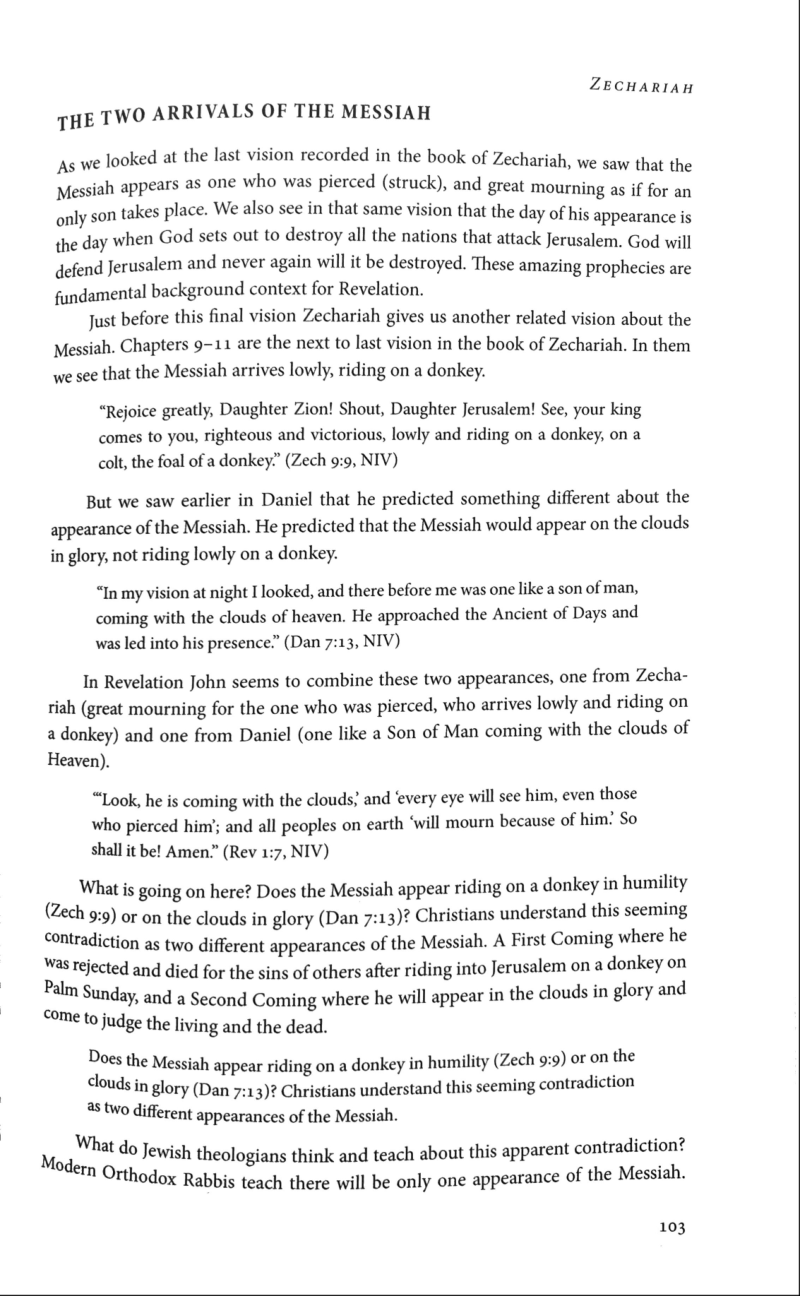Brian E. Barnes discusses the depiction of the Son of Man in Daniel 7 and the Second Coming of Jesus in the Book of Revelation.
- Type
- Book
- Source
- Brian E. Barnes Non-LDS
- Hearsay
- Direct
- Reference
Brian E. Barnes, Understanding Revelation: The Sola Scriptura Challenge (Eugene, Oregon: Wipf & Stock, 2022), 103-4
- Scribe/Publisher
- Wipf and Stock Publishers
- People
- Brian E. Barnes
- Audience
- Reading Public
- Transcription
THE TWO ARRIVALS OF THE MESSIAH
As we looked at the last vision recorded in the book of Zechariah, we saw that the Messiah appears as one who was pierced (struck), and great mourning as if for an only son takes place. We also see in that same vision that the day of his appearance is the day when God sets out to destroy all the nations that attack Jerusalem. God will defend Jerusalem and never again will it be destroyed. These amazing prophecies are fundamental background context for Revelation.
Just before this final vision Zechariah gives us another related vision about the Messiah. Chapters 9-11 are the next to last vision in the book of Zechariah. In them we see that the Messiah arrives lowly, riding on a donkey.
“Rejoice, greatly, Daughter Zion! Shout, Daughter Jerusalem! See, your king comes to you, righteous and victorious, lowly and riding on a donkey, on a colt, the foal of a donkey.” (Zech 9:9, NIV)
But we saw earlier in Daniel that he predicted something different about the appearance of the Messiah. He predicted that the Messiah would appear on the clouds in glory, not riding lowly on a donkey.
“In my vision at night I looked, and there before me was one like a son of man, coming with the clouds of heaven. He approached the Ancient of days and was led to his presence.” (Dan 7:13, NIV)
In Revelation John seems to combine these two appearances, one from Zechariah (great mourning for the one who was pierced, who arrives lowly and riding on a donkey) and one from Daniel (one like a Son of Man coming with the clouds of heaven).
“’Look, he is coming with the clouds,’ and ‘every eye will see him, even those who pierced him’; and all peoples on earth ‘will mourn because of him.’ So shall it be! Amen.” (Rev 1:7, NIV)
What is going on here? Does the Messiah appear riding on a donkey in humility (Zech 9:9) or on the clouds in glory (Dan 7:13)? Christians understand this seeming contradiction as two different appearances of the Messiah. A First Coming where he was rejected and died for the sins of others after riding into Jerusalem on a donkey on Palm Sunday, and a Second Coming where he will appear in the clouds in glory and come to judge the living and the dead.
Does the Messiah appear riding on a donkey in humility (Zech 9:9) or on the clouds in glory (Dan 7:13)? Christians understand this seeming contradiction as two different appearances of the Messiah.
What do Jewish theologians think and teach about this apparent contradiction? Modern Orthodox Rabbis teach there will be only one appearance of the Messiah. They teach that the Messiah will appear only one way or the other, depending on if the Jewish People deserve redemption or not. In other words, if the Jewish people do enough good in repairing our broken world, then the Messiah will appear on the clouds as a reward. Otherwise, he will appear in humility to their shame. We can see this view most clearly in the Talmud.
“Rabbi Alexandri says: Rabbi Yehoshua ben Levi raises a contradiction between two depictions of the coming of the Messiah. It is written: ‘There came with the clouds of heaven, one like unto a son of man . . . and there was given him dominion and glory and a kingdom . . . his dominion is an everlasting dominion’ (Daniel 7:13-14). And it is written: ‘Behold, your king will come to you; he is just and victorious; lowly and riding upon a donkey and upon a colt, the foal of a donkey’ (Zechariah 9:9). Rabbi Alexandri explains: If the Jewish people merit redemption, the Messiah will come in a miraculous manner with the clouds of heaven. If they do not merit redemption, the Messiah will come lowly and riding upon a donkey.” (Talmud Sanhedrin 98a:13)
To better understand how to resolve this apparent contradiction, for which Christians see two comings of Christ and rabbis see only one (with an assumed choice in how he will appear based on if the people deserve reward or shame), we need to look more closely at Zechariah’s entire vision in which the Messiah appears lowly and riding on a donkey. Elsewhere in that same vision (Zech 9-11) we will see that there are actually two shepherds described. The first one is sent by God and rejected. The second one turns out to be worthless.
- Citations in Mormonr Qnas
The B. H. Roberts Foundation is not owned by, operated by, or affiliated with the Church of Jesus Christ of Latter-day Saints.

